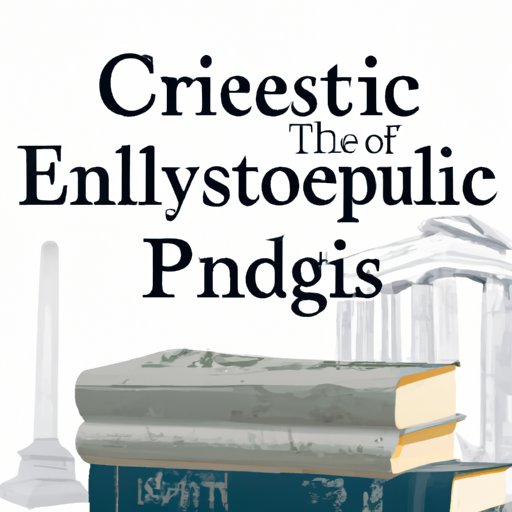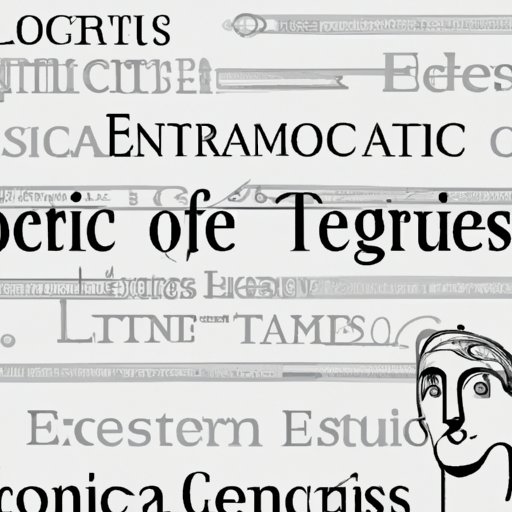Introduction
Neoclassical literature is a type of writing that draws upon the conventions and stylistic elements of classical literature, such as those found in Ancient Greece and Rome. This type of literature typically features formal structures and styles, along with themes and characters that often evoke moral and philosophical messages. In this article, we will explore the key elements of neoclassical literature, its influence from ancient Greek and Roman literature, and its legacy in modern writing.

An Exploration of the Key Elements of Neoclassical Literature
At its core, neoclassical literature is characterized by its adherence to the conventions and stylistic elements of classical literature. This includes a focus on formal structures and styles, such as the use of a three-part structure (beginning, middle, and end) and the use of rhetorical devices, such as irony, metaphor, and simile. Neoclassical literature also tends to feature characters who are either idealized or flawed, with both types serving as foils for one another. Common themes in neoclassical literature include morality, virtue, and the pursuit of knowledge.
Understanding the Influence of Ancient Greek and Roman Literature on Neoclassical Literature
The influence of ancient Greek and Roman literature on neoclassical literature is undeniable. The works of Homer, Virgil, and other classical authors served as a source of inspiration for neoclassical writers, as did the ideas of the Enlightenment philosophers. According to scholar Robert L. Mack, “the Enlightenment was marked by a revival of interest in classical antiquity, a renewed appreciation of the Greeks and Romans as sources of inspiration for modern culture.” This sentiment is echoed by scholar Stephen M. Fallon, who states that “the neoclassical period was shaped by a deep respect for the achievements of classical antiquity and an admiration for the values and ideals enshrined in it.”

A Study of the Rise of Neoclassical Literature in England
The rise of neoclassical literature in England began in the late 17th century and continued through the 18th century. During this time, writers such as Alexander Pope, Jonathan Swift, and Samuel Johnson wrote works that were heavily influenced by the ideas of the Enlightenment and the conventions of classical literature. These writers sought to combine the best of both worlds – the rationality of the Enlightenment and the beauty and poeticism of classical literature – to create works that would appeal to a wide audience.

Exploring the Legacy of Neoclassical Literature in Modern Writing
The influence of neoclassical literature can still be felt in modern writing. Writers such as T.S. Eliot and Virginia Woolf have been heavily influenced by neoclassical literature, incorporating its themes and stylistic elements into their works. For example, Eliot’s poem “The Waste Land” draws heavily on the themes of morality and virtue found in neoclassical literature, while Woolf’s novel “Mrs. Dalloway” employs many of the same formal structures and styles.
In addition, modern writers continue to draw upon the conventions and stylistic elements of neoclassical literature when crafting their works. This can be seen in the work of contemporary authors such as Margaret Atwood, J.K. Rowling, and Cormac McCarthy, all of whom employ elements of neoclassical literature in their writing.
Conclusion
In conclusion, neoclassical literature is a type of writing that draws upon the conventions and stylistic elements of classical literature, such as those found in Ancient Greece and Rome. It is characterized by its formal structures and styles, along with themes and characters that often evoke moral and philosophical messages. Its influences can be traced back to ancient Greek and Roman literature, as well as to the ideas of the Enlightenment philosophers. Finally, its legacy can be seen in the works of modern writers, who continue to draw upon the conventions and stylistic elements of neoclassical literature in their writing.
Overall, neoclassical literature has had a profound effect on the development of modern literature, and its influence can still be seen in the works of contemporary writers. As such, it is important to understand the basic foundations of neoclassical literature in order to fully appreciate its impact on modern writing.
(Note: Is this article not meeting your expectations? Do you have knowledge or insights to share? Unlock new opportunities and expand your reach by joining our authors team. Click Registration to join us and share your expertise with our readers.)
